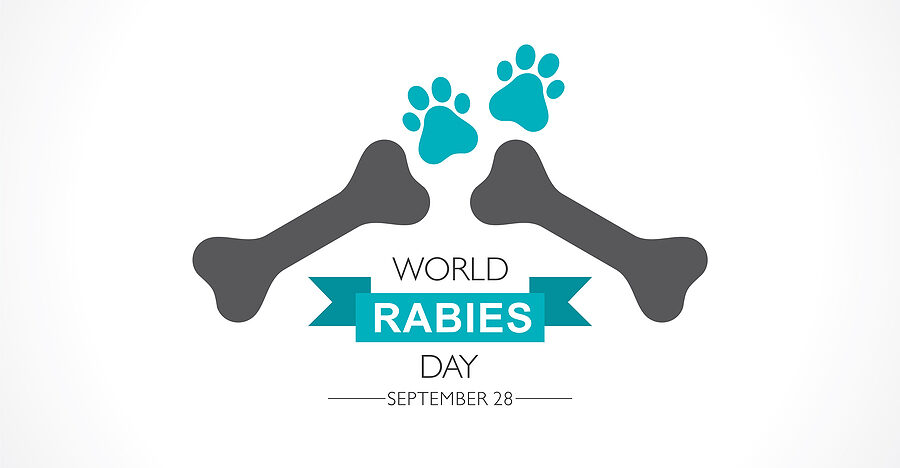September 28th, marked as World Rabies Day, serves as a global reminder of the efforts taken to eradicate this deadly disease. Despite being 100% preventable, rabies continues to claim numerous lives each year.
This blog aims to raise awareness about the disease’s symptoms, the importance of the rabies vaccine, and the prevention measures everyone should be aware of. By understanding the threat and taking appropriate steps, we can contribute to the worldwide goal of Rabies: Zero by 2030.

Let’s Celebrate World Rabies Day By Spreading Knowledge
What is Rabies?
Rabies is a viral disease that affects the central nervous system and can be transmitted from animals to humans. It is mostly caused by bites or scratches from infected animals, such as dogs, bats, raccoons, foxes, skunks, and coyotes. Once the virus enters the body, it travels through the nerves towards the brain and spinal cord, leading to inflammation and eventually causing death.
Symptoms of Rabies
The initial symptoms of rabies can be vague, making it challenging to diagnose in the early stages. However, as the disease progresses, symptoms become more severe and can include fever, headache, weakness, fatigue, anxiety, confusion, hallucinations, hydrophobia (fear of water), excessive salivation, and paralysis. It is crucial to seek immediate medical attention if you have been bitten or scratched by an animal or experience any of these symptoms.
Rabies Treatment Options
Once symptoms appear, rabies is almost always fatal. That is why prevention is the best form of protection against this deadly disease. However, if you have been bitten or scratched by an animal, immediate medical attention is necessary. The doctor will thoroughly clean and disinfect the wound and administer a series of vaccines to prevent the virus from causing infection.
Importance of the Rabies Vaccine
The most effective way to prevent rabies is through vaccination. The rabies vaccine can protect individuals from contracting the virus and developing the disease, even after exposure. The World Health Organization recommends that all dogs, cats, and ferrets be vaccinated against rabies annually. Additionally, individuals who are at a higher risk of exposure to the virus, such as veterinarians and animal handlers, should also receive the vaccination.
Prevention Measures
Apart from getting vaccinated, there are other measures we can take to prevent rabies. Avoiding contact with wild or stray animals and teaching children to do the same is essential. If you come into contact with an animal, especially if it appears sick or acts strangely, seek medical attention immediately. Additionally, it is crucial to keep your pets up to date on their rabies vaccinations and not allow them to roam freely.
The Importance of Safe and Humane Wildlife Removal and Control Services
Wildlife is an essential part of our ecosystem and plays a crucial role in maintaining balance in the natural world. However, when wildlife starts encroaching on human habitats, it can become a nuisance and even pose safety risks. In such situations, it is important to understand the importance of safe and humane wildlife removal and control services.
As human populations continue to expand, there is less space available for wildlife to thrive in their natural habitats. This leads to increased interactions between humans and wildlife, resulting in conflicts. Wildlife may damage property, spread diseases, or even attack humans or pets when they feel threatened. Removing nuisance animals from these situations can help prevent further damage and ensure the safety of both humans and animals. However, it is important to handle these situations carefully and humanely.
Join the Fight Against Rabies
As we observe World Rabies Day, let us remember that this disease is preventable, and we all have a part to play in eradicating it. By being aware of the symptoms and taking necessary precautions, we can protect ourselves and our loved ones from this deadly disease. Let us join hands and strive towards Rabies: Zero by 2030. Together, we can make a difference!
Would you like to learn more about protecting your premises against wild animal intrusions and threats? Contact Budget Animal Removal at 317-875-3099 for DNR licensed and insured wildlife removal and control services in Indianapolis and its surrounding counties. Request a free estimate or advice, today!
Related Posts:
Current Efforts to Reduce Rabies in U.S. Racoon Populations
What to Consider When Hiring an Indiana Wildlife Control Company
Today is National Squirrel Appreciation Day!



